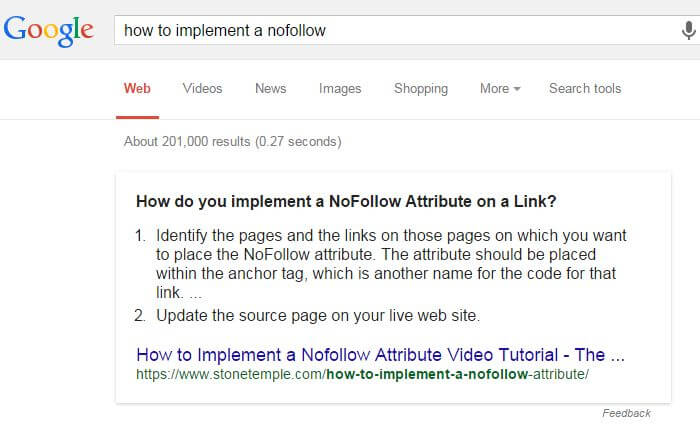
In this highly competitive world where 3 fits into the space of 2, it is high time you started thinking about something more than just rank 1 on Google SERP. There is no doubt that this coveted spot still remains something desirable and envious, you have to open up to possibilities beyond this glass ceiling, so to speak. Today, SEO enthusiasts all over the globe are talking about ‘Rank Zero’, or featured snippets.
What are Featured Snippets?
When you Google something, you find that over and above the usual suggested web links ranked in the traditional manner, there is a small space cleared out for the exact answer to your question. The answer has been sourced from some website, generally one that has the perfect fit for the query you have generated through your search. If the query is too small, the answer is provided by Google by gleaning information from any website it finds fit. There is no credit for the information gleaned from the sources!
Featured snippets are not like that. Here, you attune probable answers to queries that may be used by searchers. When Google matches your content with the searched query, you stake your claim to this space above the first ranked search result. Before it comes before rank 1, featured snippets are known by the name of ‘Rank Zero’. As is obvious, your chances of getting a click-through to your website increases manifold times when your content makes it to Rank Zero.
Types of Featured Snippets
Broadly speaking, there can be 3 types of featured snippets:
- Table: Evidently, content presented in tabular form constitutes this type of featured snippet. Usual examples can be comparisons between products or services. For example, if you compare the advantages of Android when compared to iOS, the answer can be put up in tabular form.
- Paragraph: Here, the content is presented in the form of a text, may or may not be supported by a small image. If the user generates a query like “What is the general trend of digital marketing today?” the answer may be presented in a featured snippet in the form of a paragraph.
- Lists: In this type of featured snippet, the answer to the query appears in the form of a list. For example, if you search “Benefits of Morning Walk”, the answer comes in 5 or something bullet points, listing the benefits. This kind of content presentation for such queries enables the user to grasp the message quickly.
How to Hit Rank Zero or Get into Featured Snippets
Google’s featured snippets are the results that appear at the top of the search engine results page (SERP), above the organic results. These featured snippets are designed to give users the information they’re looking for as quickly and concisely as possible.
Now the question is, how do you hit this ‘Rank Zero’? There are tricks that you can try:
- To rank in Google’s featured snippets, you need to ensure that your content is well-optimized for the target keywords. This means using the target keywords throughout the content, as well as in the title, metadata, and descriptions.
- In addition, your content should be structured in a way that is easy for Google to understand. For example, use headlines and subheadings to break up text and highlight key points.
- Finally, it’s important to keep in mind that featured snippets are constantly changing. As such, it’s important to continually monitor your rankings and make sure that your content is up-to-date.
- Do a quick research of the usual queries asked in your domain of business. Check out which of them are covered by featured snippets and how effective they are. For snippets not floating around, generate some of them with the particular query in mind. For ineffective but existing snippets, do a better job and try to grab the space by displacing the existing one.
- Try not to work with too short a query when you want to develop content for featured snippets. Queries that are very short are usually answered by Google, without crediting the source, like I mentioned earlier. Instead, do a keyword research on possible queries in your domain and develop snippet content likewise. Using a tool like Keyword Explorer can help.
- Make it to the top SERP, not necessarily the rank 1 slot! The content for featured snippet is pulled up from websites making it to the first page of the search results. It need not always be the website ranked at the top. So, concentrate on a better content eligible for featuring in the coveted Rank Zero slot instead of jostling for rank #1.
- Study the length and other technicalities of featured snippets carefully. By knowing the word and character count for different types of snippets, you can optimize them for maximum leverage. If you can do a good job of the optimization, your click-through rate will shoot up drastically.
Summary
- Identify the most relevant and commonly searched for keywords in your niche.
- Create high-quality content that answers the user’s query concisely and comprehensively.
- Structure your content using H1 and H2 headings to create a clear hierarchy and make it easy to read.
- Use bullet points, numbered lists, and tables to break down complex information and make it more accessible.
- Add images and videos to your content to make it more engaging and informative.
- Optimize your content for featured snippets by including a summary of your answer in a short paragraph at the top of your page.
- Use schema markup to help Google understand the structure of your content.
- Ensure that your content is mobile-friendly and loads quickly.
- Use internal and external links to support your answer and provide additional resources.
- Keep your content up-to-date and relevant to maintain your featured snippet position.
By following these tips, you can help ensure that your website appears in Google’s featured snippets.
I have derived excellent advantages through featured snippets. Let me know about your experience of using them.


Hi I want to learn more about featured Snippets